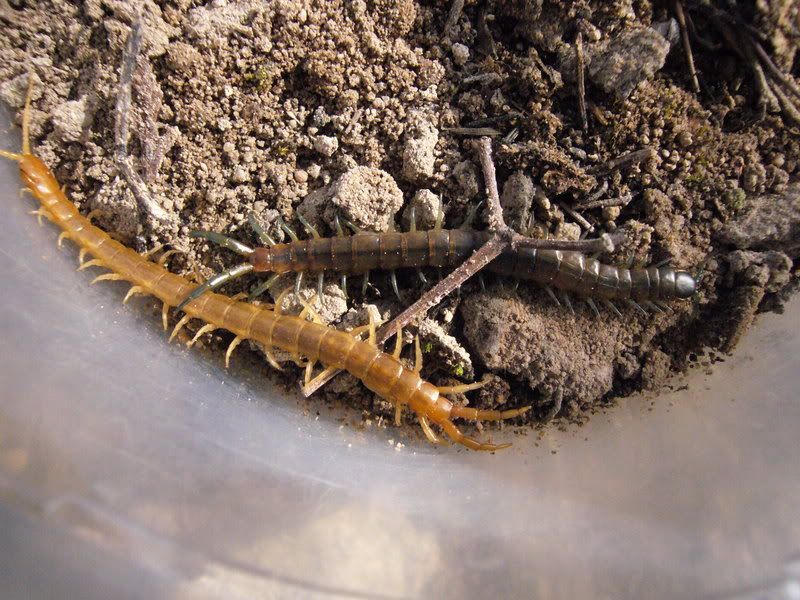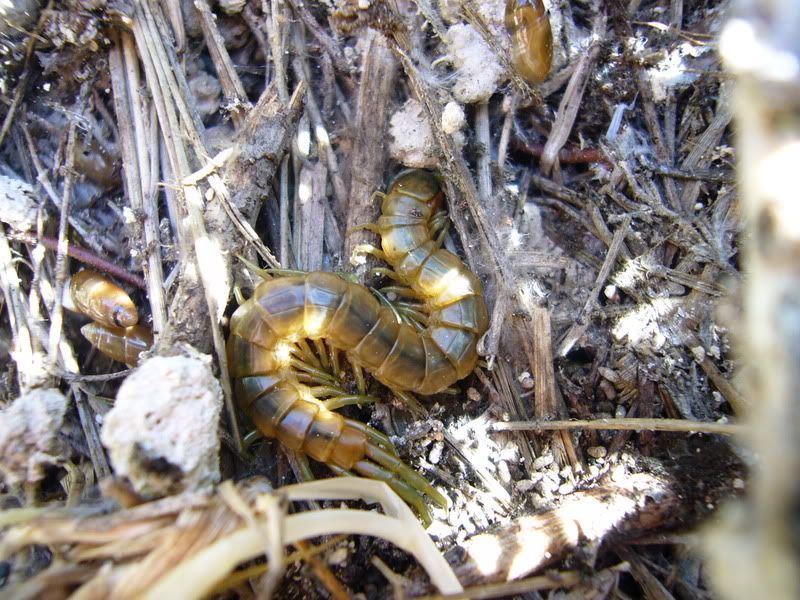Scolopendra sp. or who called robusta
- Thread starter Voks
- Start date
freedumbdclxvi
Arachnoprince
- Joined
- May 28, 2012
- Messages
- 1,426
So gorgeous!
- Joined
- Jul 4, 2005
- Messages
- 8,982
Is it a light colored Sc. galapagoensis? Did you catch it yourself?
Last edited:
- Joined
- Jul 4, 2005
- Messages
- 8,982
I think the name is not used much like it used to, but I know some people use to call galapagoensis "robusta", along with one or two other pedes, got a little confusing there, I guess it still is a little.
- Joined
- Jan 11, 2005
- Messages
- 1,141
Specific name should matter to you, because if you plan to reproduce it, you have to know what sp. is it. And also to give it the proper care with optimous conditions. That is not responsable by your side. So... that's your pede...
In the other hand, last studies consider this pede, such a Scolopendra galapagoensis, with their bright coloration.
Cheers
Carles
In the other hand, last studies consider this pede, such a Scolopendra galapagoensis, with their bright coloration.
Cheers
Carles
Actually, I have plan to breed in cross. S.gigantea, S.viridicornis, S.galapagoensis and this pede what i upload. Hope to cross breed S.morsitans came from Austrailia and Africa. Also S.subspinipes would be best start.
That would be easy if i can 'steal' and 'replace' the sperm when they are in mating. As you said, Yep That's not responsable to me. i just want to see what happen if they cross breed.
I don't have will to breed in "original descent" and to keep actual specimen title.
I herd from man that they are came from Cajamarca so i only have to do is make enviroment as simillar as there were.
You should broke idea that "same specimen has same enviroment". As specimen has variation, habitat also has variation.
That would be easy if i can 'steal' and 'replace' the sperm when they are in mating. As you said, Yep That's not responsable to me. i just want to see what happen if they cross breed.
I don't have will to breed in "original descent" and to keep actual specimen title.
I herd from man that they are came from Cajamarca so i only have to do is make enviroment as simillar as there were.
You should broke idea that "same specimen has same enviroment". As specimen has variation, habitat also has variation.
Last edited:
- Joined
- Jan 11, 2005
- Messages
- 1,141
Hello Voks,
i'm agree with you in your last sentence, but i'm not at the same level. "As the habitat has variation, the pede has variation".
Colour, in pedes, is not too significant for a big adaptation to other enviroments. In mamals, for example in humans, it was very important in the past.
More or less, all the species, are found acording some temperature and humidity parametres. And of course galapagoensis, must to be always in the same range (tropical) independely of their colouration.
Pedes are cosmopolite but a specie never lives in different biotopes (with a few exceptions like S. morsitans). But in general, one sp. belongs to a concrete biotope.
In other hand, inbreeding diferent species of pedes maybe a little difficult...i wish you the best luck for that, and of course keep us informed .
.
Cheers
Carles
i'm agree with you in your last sentence, but i'm not at the same level. "As the habitat has variation, the pede has variation".
Colour, in pedes, is not too significant for a big adaptation to other enviroments. In mamals, for example in humans, it was very important in the past.
More or less, all the species, are found acording some temperature and humidity parametres. And of course galapagoensis, must to be always in the same range (tropical) independely of their colouration.
Pedes are cosmopolite but a specie never lives in different biotopes (with a few exceptions like S. morsitans). But in general, one sp. belongs to a concrete biotope.
In other hand, inbreeding diferent species of pedes maybe a little difficult...i wish you the best luck for that, and of course keep us informed
Cheers
Carles
Thanks to reply my post and agree with my opinion. This topic is very hard to meHello Voks,
i'm agree with you in your last sentence, but i'm not at the same level. "As the habitat has variation, the pede has variation".
Colour, in pedes, is not too significant for a big adaptation to other enviroments. In mamals, for example in humans, it was very important in the past.
More or less, all the species, are found acording some temperature and humidity parametres. And of course galapagoensis, must to be always in the same range (tropical) independely of their colouration.
Pedes are cosmopolite but a specie never lives in different biotopes (with a few exceptions like S. morsitans). But in general, one sp. belongs to a concrete biotope.
In other hand, inbreeding diferent species of pedes maybe a little difficult...i wish you the best luck for that, and of course keep us informed.
Cheers
Carles
(most of my university professor majored in humanities geography so I can't say about physical geographic idea and species distribution or correlation between color, species, and space.)
Only i can say and believe is just depends on catcher's answer, my experiential idea. Still there is many arguments in evolution between geographical factor.
Yes i also hope it goes all right.
- Joined
- Jan 11, 2005
- Messages
- 1,141
Yes! That is the idea! you can correlation a pede with their distribution area acording their colour!(most of my university professor majored in humanities geography so I can't say about physical geographic idea and species distribution or correlation between color, species, and space.)
For example S. dehanni "flamelegs" lives in Myanmar and S. dehanni, "mau chau" lives only in south of vietnam. Both are the same spp.
In other hand, there is, as always an exception. Sometimes there is may colouration forms cohabiting one seme enviroment. Like the S. oraniensis that i can found in my garden.



Cheers
Carles
PD: When do you pretend to ID a pede, i just whant to say to you that first take a look to anatomy, and before, take a look to thirs colour, you will fail less pede's ID by this way ()



